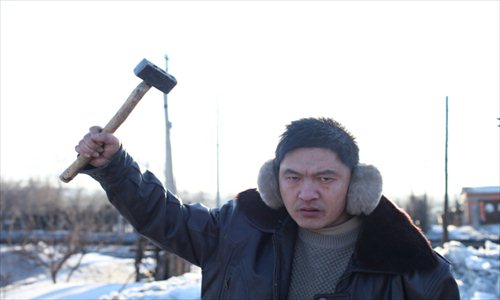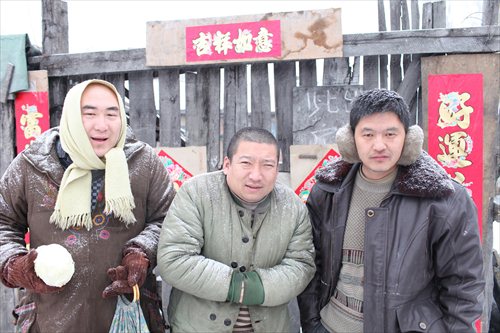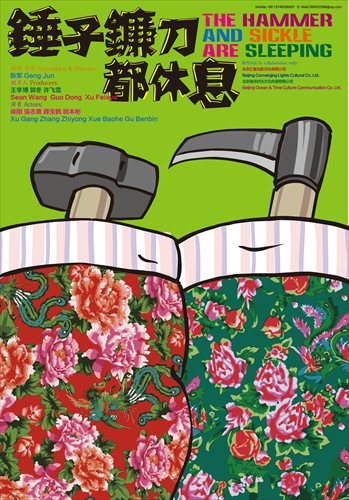HOME >> METRO SHANGHAI
The Hammer and Sickle are Sleeping
By Fang Shaoqing Source:Global Times Published: 2015-1-19 18:18:01
Bleak humor reveals underlying truths about
The Hammer and Sickle are Sleeping , directed by Geng Jun, effectively brings to life the humor and brutality of life in the less developed countryside of northeastern China.
The film won the best short film award at the 51st Taipei Golden Horse Film Festival and Awards. In a desolate village where people depend on mining for a living, the miners' pay is put into arrears. With no more earnings, they become swindlers, thieves and robbers. Dayong (played by Zhang Zhiyong), who is crippled, robs people by attacking them with his walking stick. His friend Baohe (Xue Baohe) disguises himself as an elderly woman and pretends to have lost his way, asking passers-by for money. Their tricks are not always successful, so they come up with new scams and they work together as a team.

Scenes from The Hammer and Sickle are Sleeping Photos: From the Internet
Gangzi (Xu Gang), a thief who always carries a hammer or sickle for self-defense, Dayong and Dayong's relative Xiao'er (Gu Benbin), who works for a church, end up working together to make a living. Dayong, who is the eldest, takes the lead. He tells Gangzi to use a hammer wrapped in a towel during their robberies.
At first, they work well together, but they become more nervous, until one day a female victim fights back.
The film's scriptwriter and director, born and bred in northeastern China, was inspired to make a film that described the changes in his hometown, which has seen a drop in population since his childhood.

Scenes from The Hammer and Sickle are Sleeping Photos: From the Internet
A number of long shots of the snow-covered and unfrequented roads and the shabby homes of residents set up a depressing tone, while the setting supports the black humor of the film and its characters.
Contributing to the comedic effect are the funny and even brutal action scenes shot in a northeastern style, and the northeastern dialect always adds a funny touch to the scenarios.
The dialogue between the less-educated and unemployed villagers may initially sound superficial, but the clever script is full of wordplay, and the characters are complex.They live through a series of frustrations and are active in thinking rather than being simple-minded or reckless. The emotional plot contrasts with the savage circumstances and the somewhat uncivilized actions of the characters.
The hammer that the gang uses in its jobs symbolizes the brutality that springs up in the relationship between the central characters. The weakness in this relationship - implied by the towel that is wrapped around the hammer to deaden its blows - is mirrored by the weakness that emerges in the gang's bonds.
The religious Xiao'er maintains his goodwill toward the people around him to the end, showing that human nature can redeem itself and end up in a victory for kindness, despite the circumstances.
The use of European classical music and Christian hymns creates a lot of dramatic tension and helps switch the tone from sadness to playfulness.

Scenes from The Hammer and Sickle are Sleeping Photos: From the Internet
Everyone's a critic
Yu Sun
30, Shanghainese
"I appreciate Geng Jun's black humor that reveals the conflicts of the film. When losers become the leading characters of a piece, the work is very likely to work as an allegory. Rather than being sarcastic, I believe the film indicates a positive side of life behind the most absurd scenarios. But it might be a little hard for everyone to understand the more profound messages."
Wendy Zheng
24, graduate
"Some of the lines impressed me a lot. Their feelings about human nature, friendship and romance are plain but telling and empathetic."
Jonas
28, Shanghainese
"Despite its creativeness in form, the film is technically flawed. Also, the acting of the three comedic characters is a bit overstated."
Posted in: Metro Shanghai, Culture